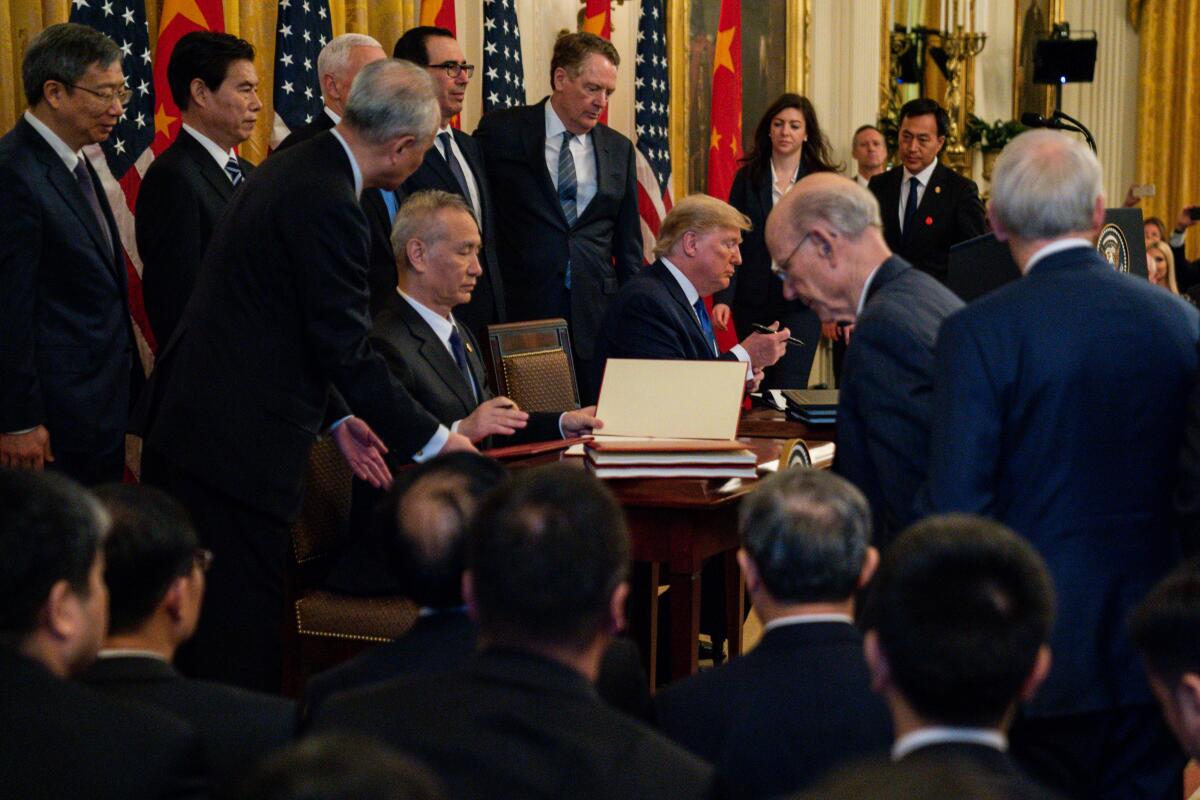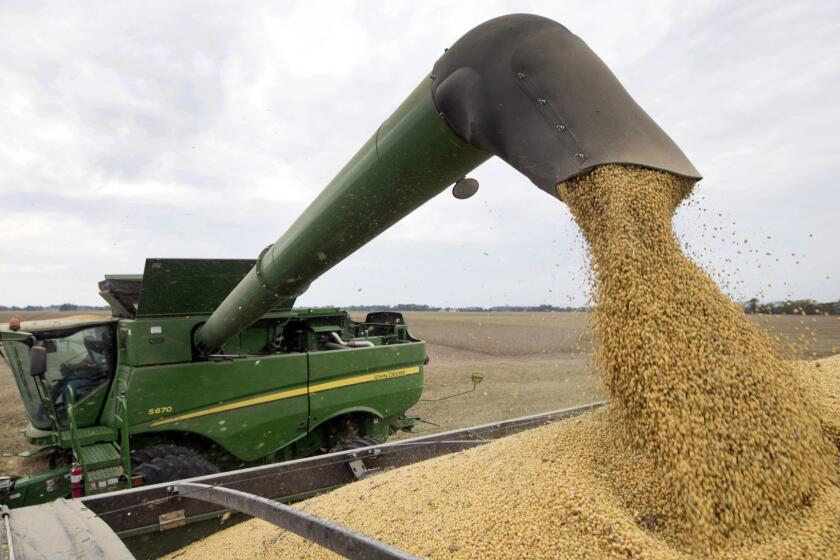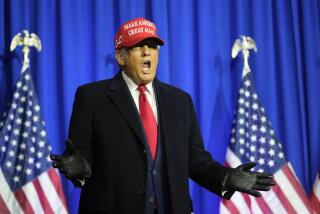Column: Trump’s China trade deal doesn’t even get us back to square one, despite immense cost

That sound you may have heard Wednesday morning was that of a heavy truck spinning its wheels, as President Trump signed an agreement with China that imposes a cease-fire in a trade war that has achieved virtually nothing for Americans, except the imposition of enormous economic costs on U.S. consumers, farmers and manufacturers.
At the signing ceremony, Trump called the deal “transformative,” which is surely an exaggeration. The agreement leaves in place most of the tariffs Trump has imposed on Chinese goods since 2018, which means that most of the retaliatory tariffs China has imposed also remain.
Notwithstanding Trump’s mantra that the tariffs are paid by the Chinese, trade experts are virtually unanimous in concluding that they’ve been paid entirely by Americans. As a result, according to recent research by the Federal Reserve, that meant higher prices for U.S. consumers, lower manufacturing growth and the cratering of agricultural exports.
This is a managed-trade agreement, not a free-trade agreement.
— Raj Bhala, University of Kansas
Steep tariffs are “the new normal in the troubled US-China economic relationship,” Chad P. Bown of the Peterson Institute for International Economics observed last month after the essentials of the deal were first announced.
Even after the agreement, the average U.S. tariff on China imports will still be 19.3%, a modest reduction from the pre-agreement level of 21% and more than six times its level of 3% before Trump launched the tariff war.
Through the deal, China commits to making $200 billion over the next two years in new purchases of agricultural and manufactured goods, services, and crude oil and other energy. But there are widespread doubts that China actually can absorb imports on such a scale. That points to the question of how its commitments can be monitored and enforced.
Farm prices are down, bankruptcies are up, farm equipment is getting more expensive and export markets are fading away: Is there anything to like about the impact President Trump has had on the agricultural economy of the United States?
The agreement incorporates a bilateral enforcement mechanism, but Trump has displayed profound hostility to other international trade enforcement bodies, notably the World Trade Organization, which could have been brought in to oversee China’s compliance.
If China fully complies with all the terms of the deal, that would go a long way to meeting one of Trump’s explicit goals on trade policy -- reducing China’s enormous trade surplus with the U.S., which reached a record $323.3 billion in 2018. The surplus fell last year to $295.8 billion largely because of the tariffs, but that was still larger than in any year other than 2018.
But the deal does little to affect the structural imbalance in U.S.-China trade -- the inbred factors that prompt Americans to buy more from China than U.S. manufacturers and growers sell there. “This is a managed-trade agreement, not a free-trade agreement,” says Raj Bhala, an international trade expert at the University of Kansas School of Law.
That prompts doubts about how U.S.-China trade will look after the specific commitments expire in two years, especially since the agreement signed Wednesday fails to cover some of the non-tariff trade barriers that keep China’s markets largely closed to U.S. manufacturers and that ostensibly prompted Trump’s trade war in the first place. These include government procurement restrictions and subsidies to state-owned enterprises.
“Not tackling China’s subsidies is a giant hole in the phase one deal,” Bown tweeted after Wednesday’s signing ceremony. “There’s no way to get around it.”
We’ll say this for President Trump: When he misunderstands something, he misunderstands it more than anyone else in creation.
Although the agreement hints at progress on such issues as Chinese theft of technology, it doesn’t address what Bhala calls “21st century intellectual property issues,” such as privacy protections.
Finally, the deal doesn’t touch China’s greater ambitions as an economic player, such as those embodied in its “Made in China 2025” 10-year plan unveiled in 2015. The plan calls for China to become the dominant global force in electric cars, aircraft manufacture, biotechnology, advanced telecommunications, robotics and artificial intelligence.
Administration figures have argued that the costs of the trade war are short-term, and that over time it will yield gains in employment and national security. Economists are doubtful, based on their historical sense that trade wars typically have no winners.
“While the long-run effects are still to be seen,” observed researchers headed by Mary Amiti of the Federal Reserve Bank of New York, in the first year of the tariffs “the U.S. experienced substantial increases in the prices of intermediates and finished goods, ... reductions in availability of imported varieties, and complete passthrough of the tariffs into domestic prices of imported goods.”
To briefly recap the trade war, Trump imposed tariffs on some $360 billion in Chinese goods starting in mid-2018. Most of those tariffs will remain in place in the wake of the agreement, although tariffs on about $112 billion in consumer goods such as clothing and sports equipment will be cut to 7.5% from 15%, and threatened 25% tariffs on an additional $160 billion -- including cellphones and computers -- will be held in abeyance.
And 25% tariffs remain in effect on the rest of the imports, including raw materials and components used by U.S. manufacturers to make products domestically. Trump says that the remaining tariffs won’t be reconsidered until after the election.
The tariffs not only flowed through to U.S. consumers via higher domestic prices, but they also cost American companies in time and effort to find new suppliers outside China. American exports to China fell because of retaliatory tariffs imposed by Beijing on more than $110 billion in goods such as steel, aluminum and agricultural products. The farm economy was profoundly harmed: For example, purchases of soybeans by China, formerly the leading export partner of U.S. soybean farmers, fell to zero in November 2018.
The costs of the trade war to other sectors also have been significant. The Trump administration has announced roughly $28 billion in emergency aid to farmers affected by the trade war. U.S. taxpayers will foot the bill for those payouts, on top of the higher prices they’re paying for imported and tariff-affected domestic goods. (Most of the agricultural aid, as we’ve reported, goes to wealthy farmers and agribusinesses.)
Column: California’s dairy farmers were struggling to regain profitability. Then came the trade wars
“The overall feeling is that we hit ‘peak cow’ five or six years ago.”
An estimated $41 billion has been raised from the China tariffs thus far. According to Amiti, “This tariff revenue is a pure transfer from domestic consumers to the government.” That would be tantamount to about two-tenths of 1% of gross domestic product, characterized by Amiti as a “deadweight loss” to the economy.
Plainly, there are sound economic reasons to reconsider the trade war. Those don’t seem to have entered into the administration’s calculations, which appear to be much more focused on politics. Both sides have immense incentives to quell the wartime rhetoric and keep their guns holstered -- for the moment. Trump faces an impeachment trial followed by a presidential election, amid signs that economic growth is slowing. The Chinese regime faces civil unrest as well as a slowdown in economic growth.
Once those conditions pass, however, so will the conflicts. As Claire Reade, a former U.S. trade enforcement official, told my colleague Don Lee, “the fundamental tensions between the U.S. and China will not subside, even if the administration has achieved some incremental progress as well as met certain political goals that could calm the relationship for the short term.”
The biggest question raised by the Phase 1 agreement is whether China is serious about its import commitments. Many experts call them “ambitious,” which is a polite way of saying “unlikely.”
Since taking over in 2011 as chief executive of JLab Audio, a maker of consumer wireless audio products, Win Cramer has been almost constantly on the road.
Consider the commitment of more than $52 billion in energy imports over two years. China imported about $8 billion a year in crude oil, liquefied natural gas and other energy products from the U.S. in 2017 and 2018, but the trade fell off sharply last year during the trade war.
The agreement suggests that Chinese imports would more than triple, which would be an enormous ramp-up, considering that the country has other import sources and is also trying to develop domestic exploration. In any case, American crude is different from the feedstock that China’s refineries are designed to use.
Ironically, for all that the administration is touting the agreement as one that “rights the wrongs of the past,” as Trump put it at the signing ceremony, it may well knit the two countries closer together in an uncomfortable interdependent relationship. American manufacturers and growers may become dependent on the import target written into the deal -- increasing their risks if they ramp up to meet a Chinese demand that could disappear after the deal’s expiration.
The U.S. remains China’s largest single export market, and China is America’s largest supplier of imported goods. Trump’s trade war hasn’t changed that yet, nor has it seemed to alter the trajectory of the trade relationship for the future. He has just made it more expensive.








